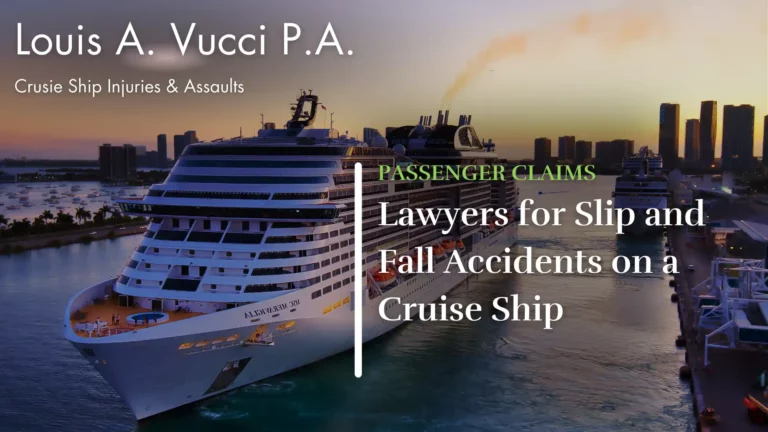Menu
Free Confidential Consultation

The serene environment of a cruise ship can quickly become perilous when slip and fall accidents occur. These incidents are far from rare and can result from a confluence of factors such as wet surfaces, poor maintenance, and inadequate safety measures. Imagine this: you’re heading towards the pool when, without any warning, you slip on a slick deck—a hidden hazard that the cruise line should have taken care of.
Areas like:
Accidents are common on cruise ships, which places the onus on the cruise line to maintain these areas. They must also ensure the safety of both passengers and crew members by protecting them against potential risks. However, when they fall short, whether by neglecting a wet floor or a poorly lit stairwell, it’s the passengers who suffer the consequences.
This emphasizes the vital role of cruise lines in these situations. It sets the foundation for a thorough exploration of the causes behind slip and fall accidents, including those on cruise ships.
In addition to passenger injuries, cruise ships can suffer ship-wide incidents such as loss of power, collisions, and unintentional groundings. These can negatively affect passengers and may put them and the crew at risk of injury or even death. Windstar Cruises is no exception. Several incidents involving the cruise line have occurred over the years.
In November 2015, a female passenger on the Star Breeze fell overboard in the Mediterranean Sea near Italy. Crew rescued her within about an hour of her falling in the water. Another incident involving Windstar Cruises occurred in April 2018 when the Star Pride experienced power problems, and most of the ship lost electricity for three days. The following year, the Wind Spirit experienced electrical failure and a total blackout, which caused steering loss and led to the ship striking two boats in French Polynesia.
Peeling back the layers reveals that slip and fall accidents on cruise ships often stem from a few common causes. Each cause, from slippery decks to shoddy maintenance, paints a picture of negligence that cruise lines must answer for. Understanding these causes not only helps in preventing future incidents but also sheds light on the liability aspect of these accidents.
In the subsections below, we’ll examine the specific factors that make a cruise ship’s deck a dangerous place, how maintenance errors can result in injuries, and the implications of inadequate safety measures on a vacation. Let’s traverse these stormy waters together, beginning with the ever-present risk of wet surfaces.
A cruise ship’s deck is often a hive of activity and, unfortunately, a prime location for slip and fall accidents. Wet surfaces are the usual suspects here, becoming slippery from sea spray, rain, or water from the swimming pool. Imagine the deck after a tropical downpour or poolside where the joy of a refreshing swim can quickly turn into a hazardous slip if proper precautions aren’t in place.
Maritime law mandates that cruise ship operators must ensure decks are slip-resistant under both wet and dry conditions, under its watchful eye. If you’ve suffered a fall due to a deck being perilously slippery without appropriate warning signs or anti-slip measures, it indicates negligence. As a result, the cruise line could be held accountable. It’s a stark reminder that with the thrills of the high seas come responsibilities that cannot be ignored.
The integrity of a cruise ship’s infrastructure is vital to passenger safety. However, when poor maintenance leads to uneven flooring or broken tiles, the risk of a fall accident skyrockets. These tripping hazards can lurk anywhere on a cruise ship, from the grandeur of the main lobby to the intimacy of a corridor, waiting for an unsuspecting passenger to take a misstep.
In areas where the dim glow of mood lighting is part of the ambiance, such as nightclubs and casinos, inadequate lighting can turn a leisurely walk into a dangerous one. Cruise ship operators have a legal obligation to keep all public areas in good condition. Failing to do so can be viewed as a direct violation of their duty to passengers. This negligence can result in severe repercussions. It prompts us to examine the necessary safety measures to prevent these incidents.
Safety on a cruise ship is not a luxury but a necessity. Inadequate safety measures, or the complete lack thereof, can put passengers at significant risk. Cruise lines are responsible not only for providing amenities but also for ensuring the installation of non-slip surfaces and warning passengers of potential dangers. Overlooking these measures sets the stage for a slip and fall accident.
Handrails, lighting, and warning signs are just some of the safety must-haves that cruise lines are tasked with providing. Maritime law does not take kindly to lapses in these areas, requiring cruise ships to exercise a standard of reasonable care. If a cruise line fails to fulfill these obligations, they could become legally responsible for any resulting injuries. This highlights the serious nature of such accidents and their preventability.
The aftermath of a slip and fall accident on a cruise ship is often measured by the injuries sustained. From broken bones to concussions, the fall injuries that passengers suffer can range from minor to catastrophic. Consider the distress of a broken wrist or the agony of a severe knee injury; these are not uncommon outcomes of a fall incident on the high seas.
More serious consequences can include traumatic brain injuries. Spinal cord injuries may also occur, leaving lasting effects well beyond the cruise’s conclusion. The severity and variety of these injuries not only highlight the physical toll on victims but also the potential for significant financial and emotional burdens. This sharply focuses on the question of cruise line liability and the circumstances under which they can be held responsible for these accidents.
Navigating the question of liability is akin to charting a course through a complex network of legal channels. Cruise lines hold a heavy responsibility to safeguard their passengers, a duty that extends to every corner of their ships. If a cruise line fails in its duty, such as neglecting to provide non-slip surfaces in wet areas or failing to maintain staircases and flooring, it may bear the liability. The responsibility for any resulting slip and fall injuries could very well rest on their shoulders.
The waters of liability can become particularly choppy when rough seas are involved. Cruise lines must be vigilant about such conditions and take appropriate precautions to protect their passengers. If you can prove that a cruise line was aware or should have been aware of an unsafe condition and failed to act, the path to holding them accountable becomes clearer.
For passengers contemplating a slip and fall case, these considerations are critical. They underscore the importance of understanding the legal framework surrounding such incidents.
Following a slip and fall accident on a cruise ship, you might feel lost at sea, grappling with injuries and navigating through a labyrinth of legal complexities. This is where a cruise ship injury lawyer comes in, serving as your anchor in the storm. Attorneys with specialized expertise in maritime law are essential for establishing the negligence of the cruise line. They guide you through the legal process effectively.
Seeking restitution for your injuries, including medical expenses and other damages, is a challenging voyage that requires a knowledgeable navigator. A cruise ship slip and fall accident lawyer doesn’t just represent you in court; they lift the burden of legalities, allowing you to focus on what truly matters—your recovery.
Let’s embark on a journey through the specifics of maritime law and its influence on the liability and compensation in these cases.
Maritime law is a distinct entity, often extending into international waters and requiring an attorney well-versed in its intricacies for effective representation in cruise ship injury cases. The complexities of this legal area are magnified by factors such as passenger ticket contracts, which grant cruise lines a bevy of defensive advantages. To successfully navigate these waters and prove negligence, one must meticulously establish the presence of duty, breach, causation, and damages—a nuanced endeavor under maritime law.
This specialized legal framework is what makes the expertise of a cruise ship injury lawyer indispensable. They are skilled navigators who guide your case through the turbulent waters of cruise ship liability. They meticulously execute every necessary legal step, including those cases involving a crew member.
Proving negligence in a slip and fall case is akin to assembling a complex jigsaw puzzle. The burden of proof lies with the passenger, who must demonstrate that the cruise line’s negligence led to their injury. This involves gathering evidence such as photographs of the accident scene, witness testimonies, and medical records, all of which play a pivotal role in establishing the cruise line’s failure to maintain safety.
Expert witness testimony can serve as a powerful sail in the legal winds. It illustrates how the cruise line’s actions, or lack thereof, contravened safety obligations. In cases where rough seas are a factor, establishing liability may hinge on showing that the cruise line was aware of the conditions and did not take the necessary precautions to protect passengers. These steps are vital in plotting a path towards justice and compensation.
The treacherous aftermath of a slip and fall accident on a cruise ship often leaves victims with a mountain of medical bills and the potential loss of income. The silver lining is that maritime law allows for compensation. It covers both economic and non-economic damages through cruise ship injury claims. A cruise ship injury lawyer will work tirelessly to ensure every recoverable damage is accounted for. This includes immediate medical care costs, future expenses, and lost wages.
In the event that multiple passengers have suffered similar negligence, victims may find strength in numbers by joining a class action lawsuit against the cruise line. Such collective legal action can lead to substantial settlements, providing a measure of justice and financial relief to those affected. The possibility of compensation is a ray of hope for many, underscoring the importance of legal representation in such cases.
Time waits for no one, and this is particularly true when it comes to filing a cruise ship slip and fall injury lawsuit. Victims need to act quickly because cruise lines set specific time limits for taking legal action. Time limits for filing are usually specified in passenger ticket contracts. These can vary from the general statutes of limitations for personal injury lawsuits.
Being aware of these constraints is crucial. A failure to comply with the contractual time limit could mean losing the right to seek compensation for your injuries. Thus, seeking legal counsel promptly to ensure the timely filing of your claim is imperative.
In the quest for legal representation after a cruise ship slip and fall accident, one name stands out: Louis A. Vucci P.A. Our law firm is exclusively dedicated to championing the rights of cruise ship accident victims. Choosing us means entrusting your case to a team with a proven track record of success. The firm is committed to handling a wide variety of incidents at sea, including slip and fall accidents. This ensures that clients receive specialized and experienced legal counsel.
What sets Louis A. Vucci P.A. apart is:
Do not let the waves of uncertainty and complexity overwhelm you if a slip and fall accident on a cruise ship has injured you. Louis A. Vucci P.A. is prepared to lead you towards calmer waters. By dialing (786) 375-0344 or submitting a contact form, you initiate the process of exploring your legal options and setting a direction towards compensation and justice.
The proficiency and commitment of Louis A. Vucci P.A. will serve as your lifelines in these trying times. Contact us today to get the experienced legal representation you need. Deal effectively with the aftermath of your cruise ship slip and fall accident with our help.
There are many things for which a passenger may make a claim, some of which include:


